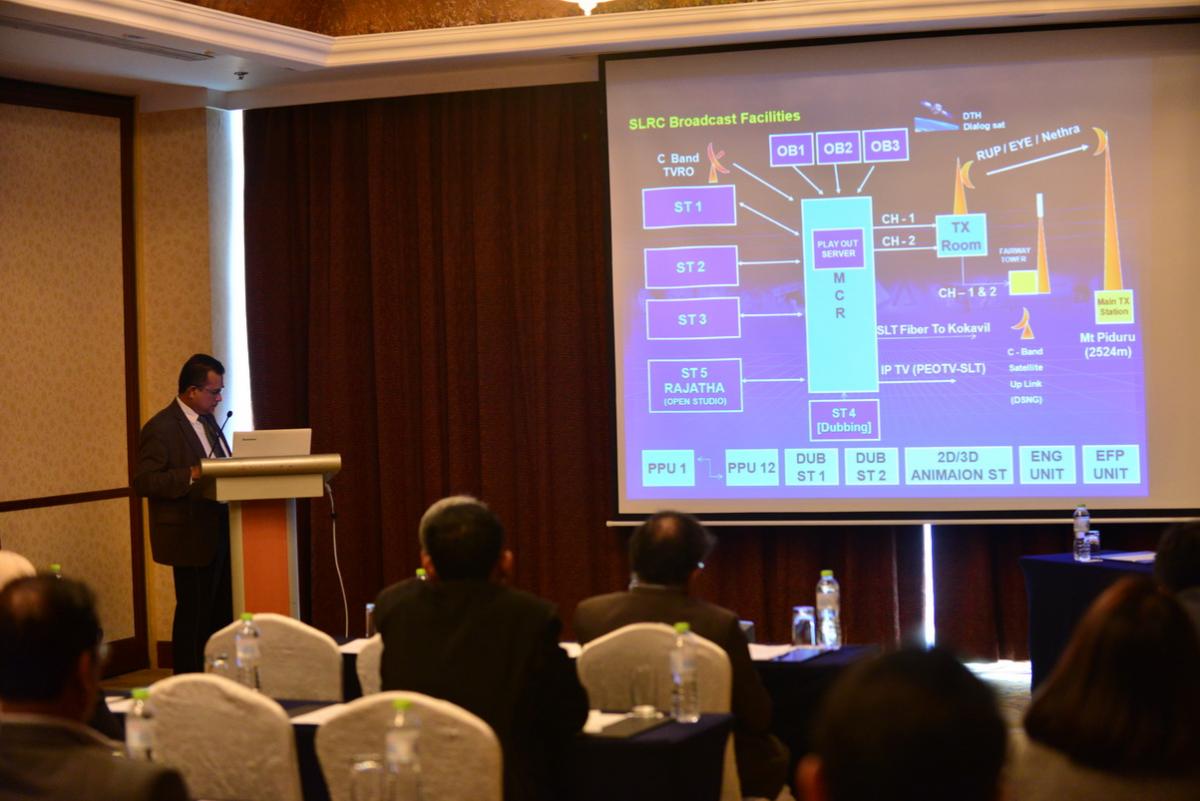The ITU Regional Office for Asia and the Pacific says costs, enormity of task, lack of government support and cooperation among stakeholders, and ever evolving technologies remain as some of the challenges in the migration from analogue to digital in the region.
“Not only does the setup of infrastructure for digital but also carrying out a simulcast service for a given period involve a lot of money and resources. On top of these the need to subsidise set- top-boxes to masses is an additional burden,” said Mr Wisit Atipayakoon, Programme Officer of the ITU Regional Office for Asia and the Pacific, Bangkok before participants at the AIBD/ITU/ABU regional workshop on “Digital Terrestrial Broadcasting TV and Radio Policy and Transition,” on 5 June 2017 in Qingdao, China.
The ITU Regional Office for Asia and the Pacific says costs, enormity of task, lack of government support and cooperation among stakeholders, and ever evolving technologies remain as some of the challenges in the migration from analogue to digital in the region.
“Not only does the setup of infrastructure for digital but also carrying out a simulcast service for a given period involve a lot of money and resources. On top of these the need to subsidise set- top-boxes to masses is an additional burden,” said Mr Wisit Atipayakoon, Programme Officer of the ITU Regional Office for Asia and the Pacific, Bangkok before participants at the AIBD/ITU/ABU regional workshop on “Digital Terrestrial Broadcasting TV and Radio Policy and Transition,” on 5 June 2017 in Qingdao, China.
Vietnam faces a similar problem. Ms Thung Mai, Senior Official of Vietnam’s Ministry of Information and Communications said the “ digitisation process is quite long and needs a big budget.” She also said there is low understanding of digitalisation which necessitates human resource training and that low-income households need to be supported as well. Vietnam hope to achieve the digital migration by 2020.
Fiji and Sri Lanka also presented a similar challenge of funding. Mr Ritesh Bilash, Engineering Manager of Fiji TV, said they need to upgrade their equipment from Standard Definition (SD) to High Definition (HD) and support citizens in acquiring set up boxes.
Mr Thusira Malawi Thantri, Director General of Sri Lanka Rupavahini Corporation, said they require digital equipment to convert much of their valuable content in analogue format stored in their archives.“ We are negotiating with Japan, Korea and the US to assist in this effort,” he said. Sri Lanka targets 2022 for its nationwide digital coverage.
At the workshop’s opening ceremony, AIBD Director Chang Jin said the Institute is committed to strengthen its programme for human resource capacity building in the broadcast industry. Mr Atipayakoon urged regional participants from Asia-Pacific and Africa to share their experiences in digital migration and continue to connect with each other and dialogue even beyond the workshop.
Giving an overview of the digital switchover in Asia-Pacific, Mr Atipayakoon said “many governments still do not consider the digital migration as a priority hence the move is not fully endorsed or supported by the necessary authorities and the necessary initiative and push.”
He also said the move to digital is not initiated as a collective effort by private broadcasters, regulators and others in many countries.
Mrs Septizar Triastika, Regulation and Legal Analyst, Broadcasting Directorate of Indonesia’s Ministry of Communication and Information Technology, shared this challenge, lamenting the rejection of local broadcast associations against some of the country’s digital regulations, thus delaying the switchover timeline. She said Indonesia expects to complete the digital switchover by 2018.
The technologies are evolving at a rapid pace. However, Mr Atipayakoon said that digital terrestrial transmission technologies are matured with a number of providers and supporters readily available. “ However, there are still cases where some still feel it may be better to wait for the next technology or next standard,: he added.
In planning the digital migration, he offered practical and essential guidelines, based on some lessons learned from those who have completed the digital migration. He said that digital switchover works well when governments are committed to the digital migration. He also suggested to have legislations, regulatory framework and a coordination body setup to drive and monitor the process and its progress.
“Close coordination and cooperation with receiver manufacturers/providers is necessary for a smooth ASO process. Without such cooperation it is not possible to ensure that consumers have access to new receiver equipment with necessary compliance at the right time,” he said.
Other suggestions he cited are to have adequate funding across the industry and the right content to attract viewers and for them to experience the benefit of digital and to hasten transition.
Dealing with the Challenges of Digital Migration
The ITU Regional Office for Asia and the Pacific says costs, enormity of task, lack of government support and cooperation among stakeholders, and ever evolving technologies remain as some of the challenges in the migration from analogue to digital in the region.
“Not only does the setup of infrastructure for digital but also carrying out a simulcast service for a given period involve a lot of money and resources. On top of these the need to subsidise set- top-boxes to masses is an additional burden,” said Mr Wisit Atipayakoon, Programme Officer of the ITU Regional Office for Asia and the Pacific, Bangkok before participants at the AIBD/ITU/ABU regional workshop on “Digital Terrestrial Broadcasting TV and Radio Policy and Transition,” on 5 June 2017 in Qingdao, China.Enhancing Audiences Viewing Experience through Virtual Reality Technology
The use of virtual studio and virtual studio implantation technology is bringing a new visual experience for the TV audience, and providing new thinking and creative new tools for television producers.
They are applications of the virtual reality technology and are becoming a new trend in the broadcast industry in Asia Pacific, Mr Huang Lei, Product Manager, Jetsen Technology Co. Ltd, Beijing, said in his presentation at a pre-summit regional workshop on augmented reality on 4 June 2017 in Qingdao, China. The workshop is a partnership among AIBD, Jetsen Technology Co., Whaley, and Bang Productions.
Demands of Cutting-edge Content
For broadcasters to develop and sustain cutting-edge content, they must ensure it is interactive and produced and delivered on multi-screens. Such content must cater to more young people and also be part of the whole industrial chain.
This advice came from Mr Lv Peng, President of Shandong TV, China, who participated in the CEO Roundtable at the 13th Asia Media Summit on 26 May 2016 in Incheon, KoreaContent is Still King
Audiences will have many screens to watch news anytime and anywhere, and to draw their attention, particularly the young, broadcast journalists must have a story to tell, one that offers accuracy, analysis, and expertise, and must help audiences make sense of it.
This approach is how BBC World Service has operated in the world, says Ms Francesca Unsworth, Director, World Serive Group, BBC, United KIngdom, emphasising that “content remains queen or king.”
‘Invasion of Globalised Content’
Asian media is raising concerns about the ‘invasion’ of globalised content on various screens that threatens local content and may necessitate government regulation such as imposing a content quota system to preserve local cultures in the region.
In Bhutan, Bollywood programmes and Korean dramas and variety shows have invaded local content, says Kinley Dorji, a journalist and Secretary, Ministry of Information of Bhutan during the Moderated Debate at the 13th Asia Media Summit in Incheon, Korea.
Monetising Content
Broadcasters were urged to preserve good content by digitising and managing it efficiently in order to share this valuable resource to future generations and enable companies to make some money.
“So much good content is stored in some offices and libraries of government agencies, private companies and broadcast organisations that unless this is digitised, it will simply vanish in three to five years,” Mr Sanajay Salil, Managing Director, MediaGuru, India, said in his presentation during the plenary session on “Monetising Content and Dealing with Copyright Issues” at the 13th Asia Media Summit on 26 May 2016 in Incheon, Korea.
Big Challenges for Broadcasters
Dato’ Sri Ahmad Shabery Cheek, Minister of Communications and Multimedia of Malaysia, raised the possibility that viewers might stop watching TV in the traditional sense unless broadcasters dealt seriously with new trends impacting their industry, among them; the rising popularity of over-the-top or OTT services, the reach and influence of social media, and evolving media consumption behaviour.
Story with Impact
Mr. Turan Ali, Director of Radio Netherlands Training Centre, Netherlands, has identified various elements in producing programmes that have an impact consistently with audiences.
Art of Good Storytelling
Ms. Poonam Sharma, Director of Singapore MediaGuru, urged broadcasters to relearn the art of good storytelling, and stressed that winning in today’s multimedia landscape means not only creating a story that is relevant and interactive, and one that provokes and engages audiences, but also delivering or executing it creatively.
Future of Broadcasting
The future of broadcasting lies not only in producing creative content that is relevant, innovative, and engaging, but also in adopting formats that keep pace with the demands of various platforms and shifting audience preferences.









